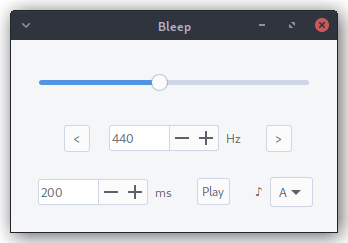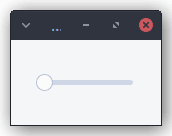IUP is a cross-platform GUI toolkit that uses native controls. It uses GTK on Linux and, well, GTK on macOS too. According to the roadmap, there is a macOS native driver in the works, but it looks like one of those perpetually "coming soon" features. There are bindings for various programming languages including a Chicken egg. Instead of building yet another calculator, let's build a GUI for generating a tone.
You'll need Chicken Scheme installed. It's available in the repositories of most Linux distros. You'll also need the IUP libraries installed before you can install the IUP egg. Unfortunately, IUP doesn't appear to be packaged for many Linux distros. Fortunately, there are pre-compiled binaries available for download on the IUP website. They are packaged as a tarball. Each tarball includes shell scripts for installing the libraries (moving them to system-wide locations for which sudo may be required depending on your distro). In addition to IUP, you also need to download two other libraries also developed by Tecgraf Institute at PUC-Rio called IM and CD. For Linux, there are different downloads for different kernel versions. These appear to correspond to versions of the Linux kernel that came with different Ubuntu releases. I use Debian Sid, which has a newer kernel than any Ubuntu release, so I just downloaded the package for the most recent kernel available, and it worked fine. Position yourself in the directory where you downloaded the tarballs and:
$ mkdir iup
$ tar -xpvf iup-*_lib.tar.gz -C iup
$ sudo iup/install
$ sudo iup/install_dev
$ sudo cp iup/ftgl/lib/Linux*/* /usr/lib64
$ mkdir im
$ tar -xpvf im-*_lib.tar.gz -C im
$ sudo im/install
$ sudo im/install_dev
$ mkdir cd
$ tar -xpvf cd-*_lib.tar.gz -C cd
$ sudo cd/install
$ sudo cd/install_dev
The above scripts install the libraries in non-standard paths on Debian, and chicken-install is unable to find them. You can use the CSC_OPTIONS environment variable to tell chicken-install where to find these files.
$ CSC_OPTIONS='-I/usr/include/iup -I/usr/include/im -I/usr/include/cd -L/usr/lib64' chicken-install -sudo iup
You'll also need to specify the dynamic library path when executing the program with Chicken.
$ LD_LIBRARY_PATH=/usr/lib64 csi bleep.scm
If using IUP from its native C, attribute setting is a separate step from object construction. The Scheme bindings add a little syntactic sugar that allow specifying your entire UI as an S-expression. Attribute names are keywords which can be passed directly to widget constructors along with child widgets. The attributes have a trailing colon. You can look up what attributes a widget accepts in the original C documentation.
(import iup)
; Main window
(define dlg
(dialog
title: "Bleep"
(vbox
alignment: 'ACENTER
gap: 25
margin: '25x25)))
(show dlg)
(main-loop)
(destroy! dlg)
(exit 0)
The vbox is an invisible widget that helps with layout. Let's start by placing a slider within this vbox.
(define slider
(valuator
min: 20
max: 20000
value: 440
expand: 'Yes))
; Main window
(define dlg
(dialog
title: "Bleep"
(vbox
alignment: 'ACENTER
gap: 25
margin: '25x25
slider)))
In IUP parlance, a slider is a valuator. IUP convention is to use "Yes" and "No" as boolean values. In Scheme you can use the 'Yes and 'No symbols. To help with organization, you can store the widget in a variable. You can add child widgets to the vbox by passing them to the vbox constructor after any other attributes (actually, the child widgets can be passed before other attributes or even mixed in with the other attributes, but I find it clearest to keep them grouped at the end).
The range of frequencies audible by humans is typically between 20 Hz and 20 KHz (we lose the ability to hear some of those higher frequencies as we age). The musical note A above middle C is 440 Hz. Since A4 serves as a general tuning standard, it seems like a sensible default, but if you run the above in Chicken, this is what you'll see:
The scale of 20 to 20,000 is so large that 440 doesn't appear to move the slider at all. Ideally, 440 would fall about the middle of the slider. To achieve this, let's use a logarithmic scale.
I found a Stack Overflow answer on how to map a slider to a logarithmic scale. The code given in the answer is JavaScript, but it was easy enough to port to Scheme.
; Scale used by slider
(define *min-position* 0)
(define *max-position* 2000)
; Range of frequencies
(define *min-frequency* 20)
(define *max-frequency* 20000)
; Logarithmic scale for frequency (so middle A [440] falls about in the middle)
; Adapted from https://stackoverflow.com/questions/846221/logarithmic-slider
(define min-freq (log *min-frequency*))
(define max-freq (log *max-frequency*))
(define frequency-scale (/ (- max-freq min-freq) (- *max-position* *min-position*)))
; Convert slider position to frequency
(define (position->frequency position)
(round (exp (+ min-freq (* frequency-scale (- position *min-position*))))))
; Convert frequency to slider position
(define (frequency->position freq)
(round (/ (- (log freq) min-freq) (+ frequency-scale *min-position*))))
I added some global parameters to the top of the script. The variable name *min-position* is just a Lisp naming convention for global parameters. I came up with the range of 0-2,000 by trial and error. It seemed to strike the best balance between each step of the slider making a noticeable change to the frequency while still allowing the user to narrow in on a specific frequency with just the slider.
Then we create two functions: one that takes the position on the slider and returns the frequency (position->frequency) and another that takes a frequency and returns the position on the slider (frequency-position). Now let's set the initial position of our slider with the frequency->position function:
(define slider
(valuator
min: *min-position*
max: *max-position*
value: (frequency->position 440)
expand: 'Yes))
Underneath the slider is a spin box showing the current frequency and buttons to increase/decrease the frequency by one octave.
(define frequency-field
(textbox
spin: 'Yes
spinmin: *min-frequency*
spinmax: *max-frequency*
spinvalue: 440))
(define frequency-controls
(hbox
alignment: 'ACENTER
gap: 25
margin: '0x0
(button title: '<)
(hbox
alignment: 'ACENTER
gap: 5
frequency-field
(label "Hz"))
(button title: '>)))
; Main window
(define dlg
(dialog
title: "Bleep"
(vbox
alignment: 'ACENTER
gap: 25
margin: '25x25
slider
frequency-controls)))
In IUP a spin box is just a text box that has the spin attribute set to "Yes." At this point, we are starting to have a nice looking interface, but it doesn't do anything. If you click the buttons or slide the slider, nothing happens. Widgets also take callbacks. Callbacks are specified just like attributes and are functions that take one or more arguments, usually self, which is the widget to which the callback belongs, and return a symbol: usually 'default but also 'close to close a dialog or others such as 'ignore and 'continue. The names of callbacks that a widget accepts and their arguments can be looked up in the original C documentation. Both the slider/valuator and the spin box have a valuechanged-cb callback (converted from valuechanged_cb in the original C API).
(define slider
(valuator
min: *min-position*
max: *max-position*
value: (frequency->position 440)
expand: 'Yes
valuechanged-cb: (lambda (self)
(attribute-set! frequency-field spinvalue:
(position->frequency (string->number (attribute self value:))))
'default)))
(define frequency-field
(textbox
spin: 'Yes
spinmin: *min-frequency*
spinmax: *max-frequency*
spinvalue: 440
valuechanged-cb: (lambda (self)
(attribute-set! slider value:
(frequency->position (string->number (attribute self spinvalue:)))))))
The attribute and attribute-set functions get the value of an attribute and set the value of an attribute, respectively. The first argument to each function is a widget, the second an attribute. When setting an attribute, you also provide an additional argument with the new value for the attribute. Attribute values are always returned as strings. Our logarithmic conversion functions take numbers, so we have to convert the attribute string to a number with string->number.
Wire the action callbacks of the buttons up to functions called decrease-octave and increase-octave. An octave is "the interval between one musical pitch and another with double its frequency."
; Set frequency slider and display
(define (set-frequency freq)
(when (and (>= freq *min-frequency*) (<= freq *max-frequency*))
(attribute-set! slider value: (frequency->position freq))
(attribute-set! frequency-field value: freq)))
; Buttons increase and decrease frequency by one octave
(define (adjust-octave modifier)
(set-frequency (* (string->number (attribute frequency-field spinvalue:)) modifier)))
(define (decrease-octave self) (adjust-octave 0.5))
(define (increase-octave self) (adjust-octave 2))
Let's use another spin box to specify the duration of the beep in milliseconds.:
(define duration-field
(textbox
spin: 'Yes
spinmin: 1
spinmax: 600000 ; 10 minutes
spinvalue: 200))
(define general-controls
(hbox
alignment: 'ACENTER
gap: 25
margin: '0x0
(hbox
alignment: 'ACENTER
gap: 5
duration-field
(label "ms"))))
; Main window
(define dlg
(dialog
title: "Bleep"
(vbox
alignment: 'ACENTER
gap: 25
margin: '25x25
slider
frequency-controls
general-controls)))
Frequency is rather abstract. Let's also give the user the ability to select a musical note. We can store the corresponding frequencies for A4-G4 in an association list.
; Notes -> frequency (middle A-G [A4-G4])
; http://pages.mtu.edu/~suits/notefreqs.html
(define notes '(("A" 440.00)
("B" 493.88)
("C" 261.63)
("D" 293.66)
("E" 329.63)
("F" 349.23)
("G" 292.00)))
We'll give the user a drop-down menu. Whenever a note is selected from the drop-down menu, we'll look up the frequency in the association list and set it using the set-frequency helper function we created for the octave buttons.
(define general-controls
(hbox
alignment: 'ACENTER
gap: 25
margin: '0x0
(hbox
alignment: 'ACENTER
gap: 5
duration-field
(label "ms"))
(hbox
alignment: 'ACENTER
gap: 5
(label "♪")
(listbox
#:1 "A" #:2 "B" #:3 "C" #:4 "D" #:5 "E" #:6 "F" #:7 "G"
value: 1
dropdown: 'Yes
action: (lambda (self text item state)
(set-frequency (cadr (assoc text notes))))))))
Now, let's make some noise. There are Chicken Scheme bindings to the Allegro library. Allegro is a library primarily used by games for cross-platform graphics, input devices, and more. What we're interested in is the audio addon that can be used to generate a tone with a sine wave. You'll need to install the Allegro library. Make sure you also install the header files. In some Linux distros, these are split into a separate package (e.g. liballegro5-dev on Debian). Also, install the Allegro egg (chicken-install -sudo allegro). I added the following lines near the top to import the Allegro bindings (and the chicken memory module, which we'll also use).
(import (prefix allegro "al:"))
(import (chicken memory))
(define +pi+ 3.141592)
You must place the code to initialize Allegro between the function to show the main IUP dialog and starting the IUP main-loop. If it comes before show, the program will die with a segmentation violation, and it can't come after the main-loop, because it would never get executed until the window closed.
; Display GUI
(show dlg)
; Initialize Allegro and audio addon
; Must be initialized afer showing the main dialog but before starting the main
; loop or else program will die with a segmentation violation.
(unless (al:init) (print "Could not initialize Allegro."))
(unless (al:audio-addon-install) (print "Could not initialize sound."))
(al:reserve-samples 0)
; Start IUP main loop
(main-loop)
(destroy! dlg)
(exit 0)
The Allegro egg is accompanied by a couple of examples but no examples showing the use of the audio addon. The Allegro library itself comes with an example showing how to generate a saw wave, but being a C library, the example is, of course, in C. I ported that example to Scheme. I would have contributed the example back to the Allegro egg, but the repo is marked as "archived by the owner" and read-only on GitHub. I've included the example in the repo alongside the rest of the code for this tutorial in case someone finds it useful.
Allegro is very low-level. You create an audio stream. In this case, the stream buffers eight fragments of 1,024 samples each at a frequency (often called sampling rate) of 44,100 Hz (the sampling rate of an audio CD), which means there are 44,100 samples per second. Each sample is a 32-bit float (what is called the bit depth of the audio), and we only have one channel to keep things as simple as possible.
; Generate a tone using Allegro
(define (generate-tone frequency duration)
(let* ((samples-per-buffer 1024)
(stream-frequency 44100)
(amplitude 0.5)
(stream (al:make-audio-stream 8 samples-per-buffer stream-frequency 'float32 'one))
(queue (al:make-event-queue))
(event (al:make-event)))
(unless (al:audio-stream-attach-to-mixer! stream (al:default-mixer))
(print "Could not attach stream to mixer."))
(al:event-queue-register-source! queue (al:audio-stream-event-source stream))
(let event-loop ((n 0))
; Grab and handle events
(when (and (< n (/ (* (/ duration 1000) stream-frequency) samples-per-buffer))
(al:event-queue-wait! queue event))
(case (al:event-type event) ('audio-stream-fragment
(let ((buffer (al:audio-stream-fragment stream)))
; If the stream is not ready for new data, buffer will be null.
(if (not buffer) (event-loop n) (begin
(fill-buffer buffer n) ; Placeholder
; Repeat
(event-loop (+ n 1)))))))))
(al:audio-stream-drain stream)))
An event loop waits for the audio stream to ask for another buffer. Our job is to fill that buffer with 1,024 32-bit floats at a time. In the code listing above, this is done by fill-buffer. That was just a placeholder, so I could break the code up into shorter, more easily explainable chunks. This is what goes in the place of (fill-buffer buffer n):
(let ((adr (pointer->address buffer)))
(let loop ((i 0))
(when (< i samples-per-buffer)
(let ((time (/ (+ (* samples-per-buffer n) i) stream-frequency)))
; al:audio-stream-fragment returns a C pointer. Use (chicken
; memory) module to operate on foreign pointer objects.
; Iterate over array four bytes at a time since 32-bit depth.
(pointer-f32-set! (address->pointer (+ adr (* i 4)))
(* amplitude (sin (* 2 +pi+ frequency time))))
(loop (+ i 1)))))
(unless (al:audio-stream-fragment-set! stream buffer)
(print "Error setting stream fragment")))
The Allegro egg is a pretty thin wrapper of the Allegro library. The audio-stream-fragment procedure in the egg just passes along the C pointer that the corresponding al_get_audio_stream_fragment function from the C library returns. It would have been nice if the egg had offered some Scheme conveniences atop Allegro like allowing us to pass a Scheme list or array to Allegro to provide the buffer of samples. Since it doesn't, we'll use the chicken memory module to fill the C array starting at the C pointer returned by audio-stream-fragment. We use pointer->address to get the address of the pointer. A pointer references a byte of memory. We can reference the preceding or following byte by subtracting or adding 1 to the address. Since we are filling the array with 32-bit floats, and 32 bits is 4 bytes, we want to increment the address by 4 each time. Then we can set the value of the current location with pointer-f32-set!.
Then you just need to feed Allegro buffers of 1,024 samples at a time. The basic formula for a sine wave is A sin(2πft) where A is amplitude, f is frequency, and t is time.
(* amplitude (sin (* 2 +pi+ frequency time)))
Wire this up to a play button, and you're ready to make some noise.
(button
title: "Play"
action: (lambda (self)
(generate-tone (attribute frequency-field spinvalue:)
(attribute duration-field spinvalue:))))
The documentation for the iup egg is pretty sparse, but this tutorial on using the iup egg was indispensable in writing the above tutorial.
You can check out the entire example on GitHub. This started as a personal learning project to explore the state of GUI programming in Lisp and has become a series of tutorials on building GUIs with various dialects of Lisp.








Oldest comments (0)